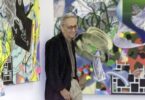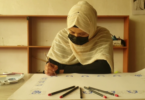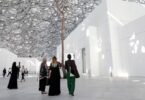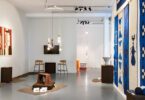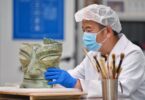Lemma Shehadi
Filmmaker Samir Abdalla grew up hearing stories of the generous Sa’idis of Upper Egypt, who had once hosted his father, the famed painter Hamed Abdalla. But an artwork commemorating his father’s time in the region was believed to have been lost for ever – until it was salvaged by Barjeel Art Foundation last year.
Now, Samir has been able to see his father’s painting for the first time, as it is on display in London as part of the UK’s largest showcase of art from the Arab world.
The Hotel of the Kings (Hotel des Rois), painted circa 1950, shows a sprawl of mud homes and domed mosques in a flat and naive style reminiscent of mosaics with earthen colours.
Hamed’s own father came from the Sa’id region, which is known for its ancient history, craft and fertile land. Green flags help date the painting to the early 1950s as they refer to the Kingdom of Egypt, which was abolished by 1953.
“Hamed Abdalla had visited Upper Egypt in the 1950s. The people there hosted him and were so kind to him. He said their hospitality was fit for a king,” says Sultan Al Qassemi, founder of the foundation in Sharjah.
The work is part of the Modern and Contemporary Art of the Arab World exhibition at Christie’s auction house. It is organised by Barjeel Art Founcation and the UAE Ministry of Culture, and is curated by Christie’s Ridha Moumni.
The exhibition is divided into two parts. The first is Kawkaba, which presents more than 100 works from the foundation’s collection. The second part, Emirati Art Reimagined: Hassan Sharif and the Contemporary Voices, presents work by one of the founding fathers of contemporary Emirati art.
Since it’s opening night, Al Qassemi says he has been moved by the overwhelming turnout – many of whom were the children and grandchildren of pioneering Arab artists.
“The first couple of days has already exceeded expectations. Over 220 people came to the reception,” he adds. “There’s excitement from the families of artists, and having them visit was definitely exciting and endearing to me.”
Some of the works have never been shown in London before. “Visitors tell me they have studied Arab art but have never seen some of the works in real life,” he says.
:quality(70)/cloudfront-eu-central-1.images.arcpublishing.com/thenational/F46ULWLRIRGDBFPT4LKFKNWAR4.jpg)
Many of these families now live in the diaspora, often because the artists themselves had settled abroad in the latter parts of their lives. The family of Sudanese painter Ibrahim El Salahi came from Oxford to see The Last Sound (1964), a work last shown in London in 2013.
These encounters are an opportunity to uncover new details about the works. Al Qassemi learnt from Samir that The Hotel of the Kings was displayed at the Marcel Bernheim Gallery, Paris, in 1956, and then left there as an IOU. “Hamed Abdalla couldn’t pay the commission and taxes from his sale of other works,” says Al Qassemi.
The Suez Canal crisis, which forced Hamed to leave Egypt, also meant he did not return to Paris for another 10 years. “By then, Bernheim had closed. Hamed died in 1985 not knowing where these paintings were,” says Al Qassemi.
The gallery had sold the painting in the 1950s, and for years it was thought to be lost. It wasn’t until someone bought it at a flea market that it was rediscovered. From that purchase, it was identified and sold at Sotheby’s auction house in London last year – where it was acquired by Barjeel Art Foundation.
Al Qassemi believes that encounters allowing audiences to reconnect with artists whose works have been lost or are rarely seen in public are part of the foundation’s mission. “We are giving these works to the public. In some cases we helped cast a spotlight on some artists who were completely forgotten,” he says.
Among the artists is Moazaz Rawda, whose white marble abstract totem-shaped sculpture sits at the centre of the exhibition hall.
Rawda was born in Baghdad in 1906 to Turkic parents from an affluent family. She became an artist in her later years, after enrolling at the Lebanese Academy of Fine Arts. “She didn’t become an artist until her fifties. She dedicated herself and applied herself to her craft,” says Al Qassemi.
Though the artist was commissioned to produce public sculptures in Lebanon, her career has been mostly obscured with time. “It was rare for a woman to be commissioned to do public artworks in the Middle East,” he adds.
:quality(70)/cloudfront-eu-central-1.images.arcpublishing.com/thenational/C73A3FGG4ZB4JM2CHWJRRGKWHA.jpg)
The exhibition makes a point of presenting an equal number of male and female artists. “The big museums in the West are skewed towards male artists. So it was important for us to show a progressive face of the Arab World that’s gender balanced and has a spotlight on minorities,” he says.
Indirectly, the exhibition reveals how minorities were actively involved in the development of modern Arab art and the political movements that surrounded it.
This is seen in the work of Egyptian artist Ezekiel Baroukh, who lived in Alexandria. His delicate portrait Mademoiselle AC (1958) is a reminder of one of the Middle East’s lost cities: Alexandria – once a crossroads for European and Middle Eastern culture.
Baroukh and his wife were participants of the Egyptian group Art et Liberte (Art and Liberty), which sought to change political and cultural life in Egypt.
“Baroukh was very involved in the art scene and political social scene. His early works are realist, but he later shifted to abstraction,” says Suheyla Takesh, a curator at Barjeel Art Foundation.
Al Qassemi hopes the exhibition will mark the beginning of a wider project – one that takes the collection around the world.
“It’s not the final exhibition, it’s one of a series that will keep taking place in London. London is important for us because there is a large Arab diaspora here, and it’s a centre of art, culture and commerce,” says Al Qassimi. “It’s not just the West for me, in fact, the East is more important. I would love to do an equivalent exhibition in Mumbai or elsewhere.”
Courtesy: thenationalnews


